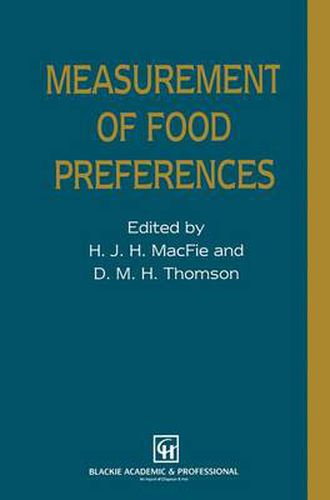Readings Newsletter
Become a Readings Member to make your shopping experience even easier.
Sign in or sign up for free!
You’re not far away from qualifying for FREE standard shipping within Australia
You’ve qualified for FREE standard shipping within Australia
The cart is loading…






This title is printed to order. This book may have been self-published. If so, we cannot guarantee the quality of the content. In the main most books will have gone through the editing process however some may not. We therefore suggest that you be aware of this before ordering this book. If in doubt check either the author or publisher’s details as we are unable to accept any returns unless they are faulty. Please contact us if you have any questions.
This book provides comprehensive coverage of the numerous methods used to characterise food preference. It brings together, for the first time, the broad range of methodologies that are brought to bear on food choice and preference. Preference is not measured in a sensory laboratory using a trained panel - it is measured using consumers by means of product tests in laboratories, central locations, in canteens and at home, by questionnaires and in focus groups. Similarly, food preference is not a direct function of sensory preference - it is determined by a wide range of factors and influences, some competing against each other, some reinforcing each other. We have aimed to provide a detailed introduction to the measurement of all these aspects, including institutional product development, context effects, variation in language used by consumers, collection and analysis of qualitative data by focus groups, product optimisation, relating prefer ence to sensory perception, accounting for differences in taste sensitivity between consumers, measuring how attitudes and beliefs determine food choice, measuring how food affects mood and mental performance, and how different expectations affect sensory perception. The emphasis has been to provide practical descriptions of current methods. Three of the ten first-named authors are university academics, the rest are in industry or research institutes. Much of the methodology is quite new, particularly the repertory grid coupled with Generalised Procrustes Analysis, Individualised Difference Testing, Food and Mood Testing, and the Sensory Expectation Models.
$9.00 standard shipping within Australia
FREE standard shipping within Australia for orders over $100.00
Express & International shipping calculated at checkout
This title is printed to order. This book may have been self-published. If so, we cannot guarantee the quality of the content. In the main most books will have gone through the editing process however some may not. We therefore suggest that you be aware of this before ordering this book. If in doubt check either the author or publisher’s details as we are unable to accept any returns unless they are faulty. Please contact us if you have any questions.
This book provides comprehensive coverage of the numerous methods used to characterise food preference. It brings together, for the first time, the broad range of methodologies that are brought to bear on food choice and preference. Preference is not measured in a sensory laboratory using a trained panel - it is measured using consumers by means of product tests in laboratories, central locations, in canteens and at home, by questionnaires and in focus groups. Similarly, food preference is not a direct function of sensory preference - it is determined by a wide range of factors and influences, some competing against each other, some reinforcing each other. We have aimed to provide a detailed introduction to the measurement of all these aspects, including institutional product development, context effects, variation in language used by consumers, collection and analysis of qualitative data by focus groups, product optimisation, relating prefer ence to sensory perception, accounting for differences in taste sensitivity between consumers, measuring how attitudes and beliefs determine food choice, measuring how food affects mood and mental performance, and how different expectations affect sensory perception. The emphasis has been to provide practical descriptions of current methods. Three of the ten first-named authors are university academics, the rest are in industry or research institutes. Much of the methodology is quite new, particularly the repertory grid coupled with Generalised Procrustes Analysis, Individualised Difference Testing, Food and Mood Testing, and the Sensory Expectation Models.